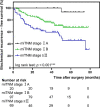PSMA-ligand uptake can serve as a novel biomarker in primary prostate cancer to predict outcome after radical prostatectomy
- PMID: 34417907
- PMCID: PMC8380207
- DOI: 10.1186/s13550-021-00818-2
PSMA-ligand uptake can serve as a novel biomarker in primary prostate cancer to predict outcome after radical prostatectomy
Abstract
Background: The prostate-specific membrane antigen (PSMA) is a relevant target in prostate cancer, and immunohistochemistry studies showed associations with outcome. PSMA-ligand positron emission tomography (PET) is increasingly used for primary prostate cancer staging, and the molecular imaging TNM classification (miTNM) standardizes its reporting. We aimed to investigate the potential of PET-imaging to serve as a noninvasive imaging biomarker to predict disease outcome in primary prostate cancer after radical prostatectomy (RP).
Methods: In this retrospective analysis, 186 primary prostate cancer patients treated with RP who had undergone a 68Ga-PSMA-11 PET up to three months prior to the surgery were included. Maximum standardized uptake value (SUVmax), SUVmean, tumor volume (TV) and total lesion (TL) were collected from PET-imaging. Moreover, clinicopathological information, including age, serum prostate-specific antigen (PSA) level, and pathological characteristics, was assessed for disease outcome prediction. A stage group system for PET-imaging findings based on the miTNM framework was developed.
Results: At a median follow-up after RP of 38 months (interquartile range (IQR) 22-53), biochemical recurrence (BCR) was observed in 58 patients during the follow-up period. A significant association between a positive surgical margin and miN status (miN1 vs. miN0, odds ratio (OR): 5.428, p = 0.004) was detected. miT status (miT ≥ 3a vs. miT < 3, OR: 2.696, p = 0.003) was identified as an independent predictor for Gleason score (GS) ≥ 8. Multivariate Cox regression analysis indicated that PSA level (hazard ratio (HR): 1.024, p = 0.014), advanced GS (GS ≥ 8 vs. GS < 8, HR: 3.253, p < 0.001) and miT status (miT ≥ 3a vs. miT < 3, HR: 1.941, p = 0.035) were independent predictors for BCR. For stage I disease as determined by PET-imaging, a shorter BCR-free survival was observed in the patients with higher SUVmax (IA vs. IB stage, log-rank, p = 0.022).
Conclusion: Preoperative miTNM classification from 68Ga-PSMA-11 PET correlates with postoperative GS, surgical margin status and time to BCR. The association between miTNM staging and outcome proposes 68Ga-PSMA-11 PET as a novel non-invasive imaging biomarker and potentially serves for ancillary pre-treatment stratification.
Keywords: 68Ga-PSMA-11 PET; Biochemical recurrence; Prostate cancer; miTNM classification.
© 2021. The Author(s).
Conflict of interest statement
ME reports patent application for rhPSMA and prior consulting activities for Blue Earth Diagnostics, Progenics Pharmaceuticals, Point Biopharma and Janssen Pharmaceuticals. Other authors declare that they have no competing interests.
Figures



References
-
- Abdel Raheem A, Chang KD, Alenzi MJ, Ham WS, Han WK, Choi YD, et al. Predictors of biochemical recurrence after Retzius-sparing robot-assisted radical prostatectomy: Analysis of 359 cases with a median follow-up period of 26 months. Int J Urol. 2018;25(12):1006–1014. doi: 10.1111/iju.13808. - DOI - PubMed
Grants and funding
LinkOut - more resources
Full Text Sources
Research Materials
Miscellaneous

